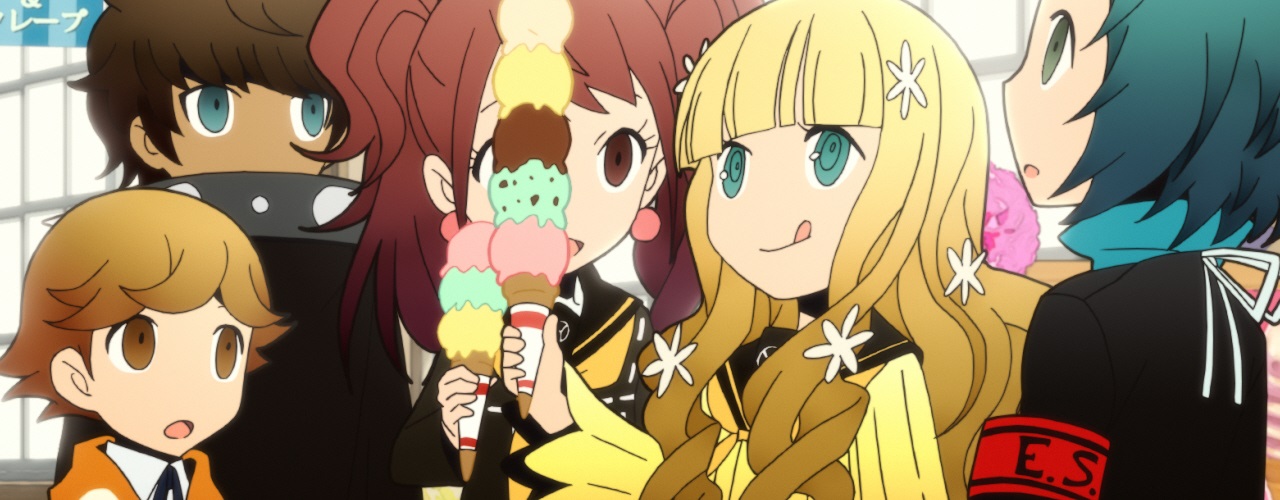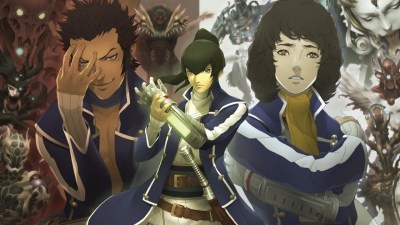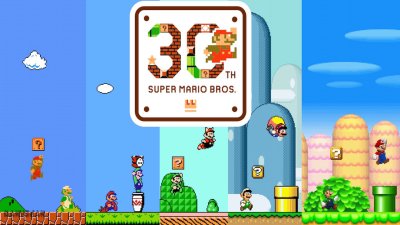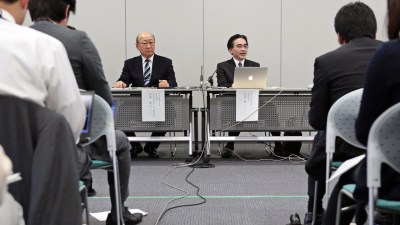Take the High School student cast of Persona 3 and Persona 4, mix them up into a first-person dungeon crawler along the lines of Etrian Odyssey, and you have something that resembles Persona Q: Shadow of the Labyrinth for the 3DS.
But as we’ve found since we started playing the imported Japanese version, there’s a bit more to it than that. We’ve spent 12 hours with the game so far and, having cleared the first dungeon, we’re excited by the possibilities of having up to 19 characters at our disposal - but concerned over how to manage them all, especially given how difficult the game is, even on the default setting.
After choosing whether to play from the perspective of the Persona 3 or Persona 4 cast (we choose the Persona 4 perspective) the tone of the game is set by a quote from Roman philosopher Lucius Anneaus Senica: “Fate leads the willing, and drags along the reluctant”.
The themes of fate and destiny are an intertwined part of the Persona ethos; throughout the series, players have visited the Velvet Room, a place where nothing occurs by chance. The ethereal residents of the Velvet Room have always gone about their duties as custodians of fate with collected coolness – after all, nothing can surprise the omniscient. Well, nothing but the events of Persona Q.
The story picks up mid-way through the Persona 4 calendar on the day of the Culture Festival – an inescapable part of the Japanese academic year. But events diverge from established canon when a mysterious bell tower erects itself in the courtyard of Yasogami High School. And the tower isn’t the only mysterious object to pop-up, either; a mysterious pair of doors, adorned with four locks, has also appeared in the Velvet Room – something even Velvet Room resident Margaret seems taken aback by.
Stumped, the Yasogami students go about enjoying the sights of the Culture Festival including an Alice in Wonderland-themed maze which makes up the first dungeon of the game. The students realize they aren’t in the school they know, but a shadow world of some sort – as evidenced by the presence of Shadow monsters. They happen upon a couple of alternate universe students trapped in the maze: the cool, calculating crossbow user Zen and the excitable, food-loving Rei.
The pair are dazed, suffering from memory loss but saddled with the niggling sensation that their memories were wiped intentionally by “someone”. Zen and Rei team up with the Yasogami students to explore the shadow world, in the hope of finding an exit.
Exploration in Persona Q harkens back to the roots of the dungeon crawler genre; the player moves around a grid-like dungeon one square at a time and the onus is on them to draw and maintain a map on the graph paper-esque display on the touchscreen. We’ve found that keeping a stylus on hand at all times is practically mandatory.
There’s a pre-selection of icons that can be used to mark warp points, doors, chests, stairs and other points of interest, but the player will have to pencil in walls themselves; fortunately, the game snaps shoddily-drawn lines into neat straights. Filling in the map methodically one square at a time is cumbersome, but there’s a sense of progress we felt working towards the 100% explored figure for each floor.
And that figure matters: each floor has a chest that only imparts its spoils once the entire map has been checked from corner to corner. The bonus loot is almost too good to pass up, we secured a Recarm card that allowed us to learn a revival skill and a Healing Stone - a renewable gem that can be used to heal 50HP (characters averaging 60-100HP) on one character once per fight.
Having a renewable healing item occupying one of the spaces in your limited 99 inventory spaces is an invaluable asset, as each item takes up a separate slot. Got 3 healing potions? That’s 3 slots. This is the same inventory shared by crafting materials gathered at Power Spots – item seeding locations that give up a handful of items each time you revisit the dungeon.
It’s also invaluable, as the SP consumed when casting magic (healing or otherwise) is at a premium – we didn’t find a single SP healing item in our 12 hours with the game. Although Zen and Rei (who act as one character with shared HP, SP, skills, equipment and character slot) have an ability that restores SP per step, we can’t see this skill being useful as SP requirements for new skills rocket.
Short of returning to the shadow school that acts as the game’s hub and paying to heal, we found prevention was the best way to keep SP levels topped. In fact, scrupulous SP use is a core part of the battle system.
Battles are semi-randomized: An icon on the right-side of the screen changes gradually from blue to red with each step – when it turns deep red a fight is initiated. Whereas fight occurrence can be predicteBd with some degree of regularity, whether you get a pre-emptive strike or back-attacked seems random - quite distressing when all five party members fail to run away from a powerful enemy that got the jump on them.
We say five party members, but technically it’s six: five attackers and one navigator (but a bit more on that in a moment). The core party of five enters battle in a set formation of two rows. Front row characters are targeted more aggressively by enemies, but hiding at the back isn’t always a good idea as characters with short-range weapons aren’t able to reach enemies (who also obey the row structure) who are in their back row. Character formations can be shuffled around mid-battle but only before any commands have been issued.
There’s a reason for this limitation: in Persona Q the party doesn’t move until everyone’s received instructions. This fixed structure forced us to learn the relative speeds of our characters to ensure who did what and when once the party was given the go sign. And as with previous Persona’s hitting enemy weaknesses is a core part of combat, albeit for a new, compelling reason.
Enemies may have weaknesses against any of the six elements (or a combination of them) as well as physical weaknesses to one of the three types of physical attack: Cutting, Piercing and Concussive.
Hitting enemies with their weakness to flip them over like pancakes before rushing them down with a group attack… is not a core part of Persona Q. It’s still possible but extremely hard to trigger; simply hitting an enemy with their weakness doesn’t guarantee they’ll fall over into a vulnerable state. Going as many as ten fights without seeing a Group Attack prompt seems to be par for course, trying to strategize around them simply isn’t viable.
No, the tangible benefit of exploiting enemy weaknesses is to save SP. Any character that exploits an enemy weakness enters Boost mode. As long as the boosted character can get to their next turn without being hit (or succumbing to a status effect) they’ll be able to cast a skill at no cost.
Boosts can even be chained; up against a group of enemies weak against fire? Cast the fire spell Agi against one of them for a free recast the next turn, and again for another freebie in the turn after that. We’ve found the most frugal use of SP is to be found by entering Boost mode by exploiting a physical weakness with a regular attack, before cashing in the boosted turns to cast magic. Sadly, many enemies only have elemental weaknesses.
The Boost system is also a part of powering characters up; the greater the number of characters in Boost mode at a battles’ conclusion the higher the chances of being awarded a Persona. And if you’re really lucky the Persona will come stocked with extra abilities pre-learnt. As always the Pokémon-like Persona can be levelled up, expanding the skill set they confer onto the character equipping them.
n a twist, all characters (barring Zen/Rei who can’t equip Persona at all) can equip a sub-Persona in addition to their fixed base Persona. This gives each character a degree of versatility. Take Chie for example, she no longer has her ice abilities as she did in Persona 4 – but you can broaden her utility in battle with an ice-magic wielding sub-Persona.
The Sub-Persona system also extends to the aforementioned navigator class characters that make use of Persona Support skills. Support skills can be exploration based such as displaying the location of treasure chests on the map or battle based skills such as guaranteeing escape from battle or raising the ATK and DEF of the entire party for a few turns.
Battle skills come at a cost though – they can only be used by expending Leader Points. During battle a gauge fills a bit each time a strike connects with an enemy, and a Leader Point is added to the potential stock of 5 each time the gauge is filled. The points carry over between battles so having LP around for an emergency escape is wise.
This is a lesson we’ve repeatedly had beaten into us during our time with the game – Persona Q is hard, or at least what we’ve played of it so far has been. Some of the larger enemies feel overpowered, and if they ambush you then there’s no guarantee you’ll get away in time to escape defeat. Thankfully, battles continue even if the party leader is knocked out.
Should the party be wiped out, any scribblings made to the map - and saved game states - carry over upon reloading; it’s a welcome concession to accessibility in a genre often known for its total lack of hand-holding. But that’s all that carries over: any money, experience or items since the last save vanish into the ether. This removes the cartographic hassle of re-mapping an area, and allows the player to quickly get back to their last explored location. But without the EXP and levels they gained whilst initially scoping their surroundings, a gap emerges between how deep the player is into a dungeon and how under-leveled they are to able to tackle it, and repeated Game Over screens only widen that gap. It seems that exercising self-restraint, and slowly building characters up again before venturing forth is going to be a must.
At least, this has been our experience so far, as we’ve opted to clear a dungeon without altering the difficulty mid-game.
Bruised and little wiser, we eventually made our way through the dungeon. Along the way we chased a rabbit through labyrinthine corridors and avoided the dreaded F.O.E’s; menacing Shadows that can be seen during ordinary exploration. The F.O.E’s in this dungeon took on the form of giant playing Card soldiers in keeping with the Alice in Wonderland theme - as did the dungeon end boss, the Queen of Hearts.
The Yasogami students put up an admirable struggle against wave after wave of the Queen’s card protectors but succumb to the realization that she has an inexhaustible supply. Fortunately the cast of Persona 3, students of Gekkoukan High School, crash the scene just in time to distract the Queen’s stooges, leaving the heroes free to fight the Queen off.
As the section we played rounded off Zen’s memory comes back in confused drabs, one of the locks on the mysterious doors in the Velvet Room comes undone. The Yasogami and Gekkoukan students decide to work together to undo the remaining 3 locks and, hopefully, escape the shadow world. Doing so means defeating the guardians of the 3 remaining dungeons. A single playthrough of Persona Q could take around 40 hours, assuming all the dungeons are the same length.
Upon returning to base we found the number of strategic options open to us had exploded. We now had a pool of 17 attacker characters and 2 navigators to mix and match, side-quests to take on for stipulated rewards, hang-out skits between characters and the ability to create new Persona from up to three other Persona.
We’re excited by the possibilities of all these options, especially as this is presumably still an early point in the game. But we do wonder how managing 19 characters will work in practice. For example, whereas equipment can be moved between active and non-active party members Persona can’t, leading to some fiddly shuffling around.
In any case, Persona Q: Shadow of the Labyrinth is due out in English later this year. Check back with us for E3 coverage on the localization and our inevitable review.




